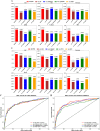NeXtMD: a new generation of machine learning and deep learning stacked hybrid framework for accurate identification of anti-inflammatory peptides
- PMID: 40660190
- PMCID: PMC12261603
- DOI: 10.1186/s12915-025-02314-8
NeXtMD: a new generation of machine learning and deep learning stacked hybrid framework for accurate identification of anti-inflammatory peptides
Abstract
Background: Accurate identification of anti-inflammatory peptides (AIPs) is crucial for drug development and inflammatory disease treatment. However, the short length and limited informational content of peptide sequences make precise computational recognition particularly challenging. While various machine learning and deep learning approaches have been explored, their limitations in feature representation and model integration hinder the effective discovery of novel AIPs.
Results: In this study, we present NeXtMD, a novel dual-module stacked framework that integrates both machine learning (ML) and deep learning (DL) components for accurate AIP identification. NeXtMD systematically extracts four functionally relevant sequence-derived descriptors-residue composition, inter-residue correlation, physicochemical properties, and sequence patterns-and utilizes a two-stage prediction strategy. The first stage generates preliminary predictions using four distinct encoding strategies and ML classifiers, while the second stage employs a multi-branch residual network (ResNeXt) to refine prediction outputs. Benchmark evaluations demonstrate that NeXtMD outperforms current state-of-the-art methods on multiple performance metrics. Moreover, NeXtMD maintains strong generalization capabilities when applied to unseen peptide sequences, showing its robustness and scalability.
Conclusions: NeXtMD offers a high-performance and interpretable computational framework for AIP identification, with significant potential to facilitate the discovery and design of peptide-based anti-inflammatory therapeutics. The architecture and methodological innovations of NeXtMD also provide a generalizable strategy that can be adapted to other bioactive peptide prediction tasks, supporting broader applications in therapeutic peptide development.
Keywords: Anti-inflammatory peptide; Bioinformatics; Deep learning; Machine learning.
© 2025. The Author(s).
Conflict of interest statement
Declarations. Ethics approval and consent to participate: Not applicable. Consent for publication: Not applicable. Competing interests: The authors declare no competing interests.
Figures









References
-
- Gupta H, Bhandari U. Molecular Insight into Obesity-Associated Nephropathy: Clinical Implications and Possible Strategies for its Management. Curr Drug Targets. 2025;26(3):188–202. - PubMed
-
- Bhat GS, Keshav TR, Hariharapura RC, Fayaz SMA. Interplay of miRNA-TF-Gene Through a Novel Six-node Feed-forward Loop Identified Inflammatory Genes as Key Regulators in Type-2 Diabetes. Curr Bioinform. 2024;19(1):73–90.
MeSH terms
Substances
Grants and funding
LinkOut - more resources
Full Text Sources
Miscellaneous

